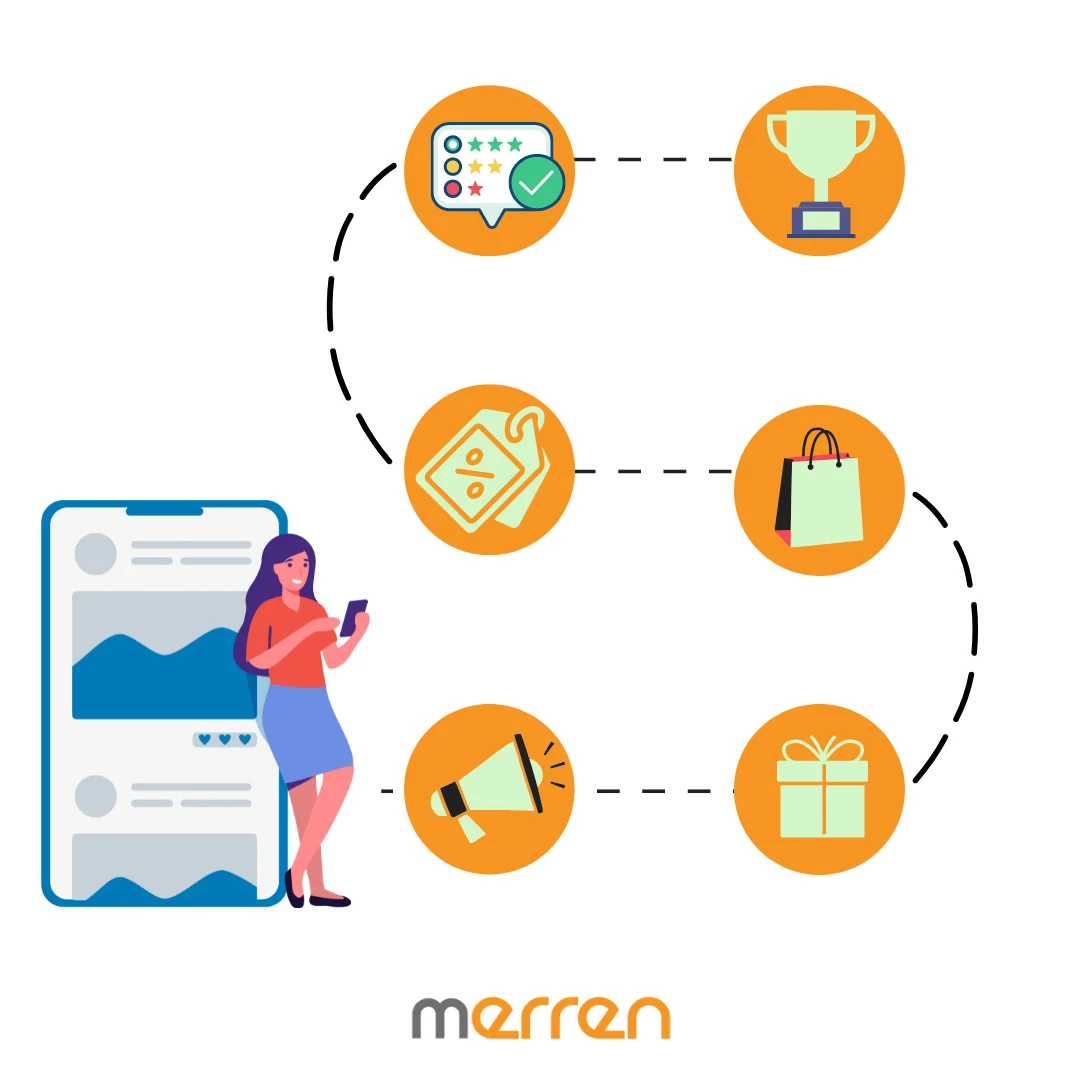A customer visits the website of a car dealership and books a test drive. As per the schedule, she takes the car for a test. Three days later she visits again to negotiate the final price but she walks away from the final offer. What went wrong? Was the test drive not satisfactory? Was the product information not adequate? Or was it just the price?
A new customer opens an account with the bank. Three months later, he contacts the call center and asks for some help with his account. The issue is resolved on the first call. Next week, the bank launches a new investment opportunity. The bank fails to check with this customer because they shuffled their contact list from oldest to newest customer.
An EdTech firm converts a lot of prospects into customers, but the quarterly churn is incredibly high. There are seven different customer touchpoints in this period, including documentation, onboarding, first sessions, first assessment etc. What isn’t working? Why is the program failing to deliver on expectations? Which touchpoint contributes the most to the discontent?
When a prospective customer decides to make a purchase from a brand, they come with certain expectations. These expectations are set through various touchpoints with the brand. Once they are inside the brand universe, these expectations run up against the actual delivery of them, again at different points of interactions with the brand. The point of interaction that builds expectations before purchase and drives delivery on brand promise post purchase is called a customer touchpoint. Understanding a brand’s performance on different stage of the customer journey provides an insight into how well the brand is living up to its promise.
Customer journey mapping is needed for two important assessments. One, at an individual level, has the satisfaction matched up to the customer’s experience with the brand. Second, on an aggregate level how satisfied are different cohorts of customers with the brand interactions.
Customer journey mapping at an individual touchpoint
Each customer comes with different challenges, emotional background, and goals. Mapping is the way to systematically identify how brands can understand this individual customer better, what path they are likely to take from being a prospect to a customer to a brand champion (or a churned
customer), how can the brand experience be personalize for this customer, and when is it time to act to drive more value, to upsell, or to avoid churn.
Mapping the customer journey at an aggregate level
When aggregated, the customer mapping journey denotes how the brand is performing at different touch points of interaction and identifying the areas of weaknesses and strengths. This understanding often is the difference between a loyal and a lost customer.
Often, overall aggregation tends to hide the issue that might exist in certain cohorts or customer stages. For example, the brand might find that the older customers are struggling to navigate through with the new website which the younger customers love. An overall aggregate might hide both these experiences. Hence, the ability to map every stage of the journey is based on cohorts that exist within the customer base. All collectively make it critical to view pain points and cater to customer needs.

Why is customer journey mapping important?
This division of a customer’s journey can help us figure out certain pointers within the organization.
Creating a well oiled sales flywheel:
The journey from brand awareness to becoming a brand champion is a long and non-linear. Each customer comes with their own variant on needs and expectations. Their initial information search can take varying forms like going to the website, visiting the store, talking to current brand users, discussing with experts etc. It is the job of the brand to equip customers with information. This is why brands offer references and expert advice upfront to close the knowledge gap. Most often, the actual user experience starts from this point onward.
Understanding the needs at each of these touchpoints and how the brand performs, can help them streamline their sales communication. This is helpful to overcome roadblocks, thereby reducing the purchase cycle, increasing conversions and customer retention.
Reducing dissatisfaction by proactively reducing expectation-delivery gaps:
Customers have certain expectations from the brand when they purchase their product. If the product is B2B, these expectations can be in the form of earning more revenue, reducing their costs, reducing time taken complete a task, or higher productivity etc. If the product is B2C, the expectations can be in the form of better personal image, health, status, lifestyle etc.
Once the customer joins the brand universe, the expectations have to deal with the challenges of onboarding, customization, value delivery, support etc. If the aim is to keep the customer satisfied, build a long term relationship, and convert them into brand ambassadors, it is the onus of the brand to reduce the gap between expectation and delivery.
Driving customer delight by helping them derive more value from their purchase:
Once the basic expectations of the customers are met, the brands needs to identify potential opportunities that would help customers derive further value from the product. The more entrenched the customer is with the product, they see more value with every use. That way, they’re less likely to churn. In fact, such customers would not only stay with the brand, but also brag about what they accomplish with it, to their peers- who often are potential customers themselves.
The truth is, customer interactions and feedback loops today are endless. How can the brands collect the information across these interactions in real-time so that timely, meaningful actions can be taken? How can the brand look to attend to their customer cohorts? And how do the brands identify the potential customers who need immediate attention?
The current scenario of customer mapping journey has room for improvement
The customer journey mapping even at large customer centric brands tend to be broken. There are some the common issues that the customer experience strategy programs suffer from. Those are:
Siloed implementation and ownership:
The customer touchpoints often span across various functions- marketing, sales, onboarding, customer success etc. Each of these functions within the company might have differing priorities, incentives, and strategies. These often lead to varying levels of interest, implementation, ownership, and use of the customer journey mapping.
When the implementation is driven by a particular function, it could lead to adhoc and siloed implementation. Customer feedback collection stays narrow in its scope and does not get distributed to the correct stakeholders. Sometimes, the same customer data is collected by multiple departments, which not just increases the cost to the company but also annoys the customer who feels unheard when the company asks repetitive questions. The bits of data collected are never brought together to look at a bigger picture. For example, poor customer satisfaction data is important for sales, marketing, customer service and the management team. It is not uncommon to see each department working with different customer satisfaction metrics.
The customer journey mapping is most useful when implemented strategically across the entire organization and spanning the entire spectrum of customer touchpoints.
Cookie cutter, non-strategic approach:
Even when the customer journey is implemented across the touchpoints, often the approach becomes narrow. For example, collecting only net promoter score (NPS) data at each touchpoint, irrespective of whether it is a relevant metric for that touchpoint or not. In fact customer effort score (CES) could be a better metric at customer support or prospecting stage. Customer satisfaction may be a superior metric to predict churn for certain product categories.
A good customer journey mapping approach will account for the relevance of key performance indicator (KPI) for each touchpoint.

High friction medium and poor quality of customer response:
Big brands are still mostly using emails as a form of communication with their leads and prospects. Let us assume a potential customer takes a brand new bike for a test ride. The smooth machine helped the customer cruise on the road and give him a whole new feeling. The manager now sends them feedback form on their email address seeking a response. The lead checks the email after 3 days and by then, the experience is now a memory.
Often the feedback forms in a spam box or get crowded by other unread emails. It is easy to ignore the emails, even with an intent of returning to them later, which of course never happens. Not only can memories mostly fade, but also tend to get colored by the customer’s other experiences. Imagine if our prospect test drove two other bikes during the time. What are the chances that they would be able to keep their experience at your dealership from being clouded by their subsequent experiences. Moreover, responding based on memory is an effort for the customer with very limited upside. It is hardly a surprise that only the most irate or delighted customers tend to respond- it is easier to keep the memory of the experience intact if the experience brought out an extreme emotion.
It is the choice of the medium (in this example, email) to collect feedback which leads to poor quality and rate of response.
The decision to choose the correct medium for feedback collection is therefore, not a trivial one. If your customer is in-store, email feedback collection does not work. Real time mediums such as SMS, RCS, WhatsApp, Facebook or Instagram Messenger would work better. If your customer is on the website, a chat bot would work better. If the customer is communicating over the email, of course the email feedback collection would be the most effective. Using the right mediums at the right time can boost your response rates.
Siloed implementation and ownership:
The customer touchpoints often span across various functions- marketing, sales, onboarding, customer success etc. Each of these functions within the company might have differing priorities, incentives, and strategies which often leads to varying levels of interest, implementation, ownership, and use of the customer journey mapping.
When the implementation is driven by a particular function, it could lead to adhoc and siloed implementation. Customer feedback collection stays narrow in its scope and does not get distributed to the correct stakeholders. Sometimes, the same data is collected by multiple departments, which not just increases the cost to the company but also annoys the customer who feels unheard when the company asks repetitive questions. The bits of data collected are never brought together to look at the big picture. For example, poor customer satisfaction data is important for sales, marketing, customer service and the management team. It is not uncommon to see each department working with different customer satisfaction metrics. All of these add to the customer pain points.
The customer journey mapping is most useful when implemented strategically across the organization and spanning the entire spectrum of customer touchpoints.
Building an ideal customer journey mapping template
We have seen why implementing a solid customer journey map is important for customer centric brands and why such programs might fail. Let’s now look at a step-by-step guide to implementing the customer journey blueprint inside an organization:
Choose the right stakeholders:
For a uniform, unbiased, and effective implementation of the customer journey mapping program within the organization requires the implementation team to bring both, the horizontal journey wide and the vertical function specific perspective. This is why these implementations are initiated and driven by the management or strategy team but pull in expertise for different functions like sales, marketing, customer success etc. Getting the right team members onboard to drive the implementation would ensure standardized implementation and organization wide buy in.
Identify the relevant customer touchpoints:
Customers get in touch with the brands in varying fashion, frequency, and situations. However, not all touchpoints contribute to the overall brand health. Sending a customer feedback survey at every
touchpoint for a high-touch brand can be annoying for the customer. Hence, it is imperative to identify the touchpoints where the feedback needs to be captured.
Identify the relevant KPIs at each customer touchpoint:
The intent of collecting customer improvement at a touchpoint is to drive improvements. These improvements can come in the form of resolution rate, effort needed to find information, satisfaction with product etc. Hence, it is important to choose KPIs for a touchpoint that are:
– Standardized i.e. can be used as a benchmark over time.
– Actionable.
– Simple to measure, track, and comprehend.
– Non-manipulable.

Identify the best medium for feedback collection:
The choice of medium would vary based on the touchpoint and is is dictated by:
– The effort needed by the customer to respond to your request for feedback.
– The medium that would help customers provide feedback closest to the time and place of interaction. This would mean using different mediums for different touchpoints. For example, chatbots work best when the touchpoint is a website. Messaging apps work best for in-store interaction as customers have access to them at the point of purchase.
– Customer preference. If your customer is most comfortable providing data through a particular channel, the preference should be honored.
Automate collection, analyses, and reporting:
In a high touch environment, it is easy for manually pushed customer feedback requests to fall through the cracks. Moreover, it can lead to a situation where requests are screened to manipulate the KPIs rendering the mapping an exercise in validation rather than improvement.
Automation leads to better quality and higher trust in KPI which in turn makes decision making more transparent, robust and confident. Automating the distribution of results to the correct stakeholders also leads to quicker and more meaningful actions based on the feedback on both the individual and the aggregate levels.
Build internal buy-in across teams:
No program, however robust and efficient, would work if the brand stakeholders do not find it relevant, useful, and transparent. If the selected KPIs are irrelevant and do not get impacted by their efforts, they would feel frustrated and cheated. If the KPIs are not transparent, it would again lead to the same feeling. If the KPI is not useful in improving their performance, it would feel like a performance evaluation or worse, a damocles sword. It is therefore important to explain the metric being measured and how it would be used to drive improvements and not just measure performance.
Review trends and measure performance frequently:
The power of customer journey mapping is that the organization can keep a tab of its performance across the touchpoints and over a period of time. In other words, they can measure the performance of the brand across each touchpoint to find the relative strengths and weaknesses. They can also measure them over time to see whether the performance at a touchpoint is improving or falling.
The more frequently these are reviewed, the more actions would be based on it and the more buy in, the program would get from the internal stakeholders.
Review touchpoints, KPIs, and channels periodically:
In a competitive and fast changing market environment, it would be unwise to think that a customer journey mapping program can stay rigid. While it is not advised to change the program too often as it would lose standardization and it’s ability to show longitudinal trends, it is almost mandatory to revisit it periodically to check for:
– New touchpoints that might have emerged.
– Relevance and actionability of the KPIs on the touchpoints.
– Better ways to distribute requests for feedback.
How can you capture your clients in the ecosystem using Merren?
Merren is more than just a survey platform. It is the world’s first end-to-end platform that can help organizations automate the entire customer mapping journey process using multiple channels of feedback collection.
Merren helps organizations map customer journeys across multiple touchpoints using multiple communication channels.
With Merren, various brands can:
- Create a multilingual, customized flow for each touchpoint.
- Use multiple channels to push out feedback surveys including emails, SMS, rich communication services (RCS), WhatsApp, Facebook messenger etc.
- Access real-time data using the Merren dashboard.
- Automate the journey maps by integrating with the CRM.
How is automating the entire customer journey going to be a game changer for brands?
Since messaging platforms bring in higher response rates, the responses are also authentic at best. More data will enable brands to have better analytical power thereby clarity in the decision making process.
Everything that we do is a domino effect. Timely data collection via messaging platforms brings in more data to analyze. This in turn helps managers understand their target audience better which enables the brands to cater to them efficiently.
Not all leads are genuine or to be actively pursued. Automating and analyzing data is a system that gets us to differentiate between potential lead and a strolling lead. This information helps in better resource allocation depending on where it is needed.
Strategy making should consider the following pointers: understanding a buyer’s persona and their initial interest in the product/ brand, their interactions and feedback, closing a knowledge barrier and how to nurture and keep them invested in each touchpoint.
Looking to build a customer journey mapping program at your organization? We will be happy to assist you here.





